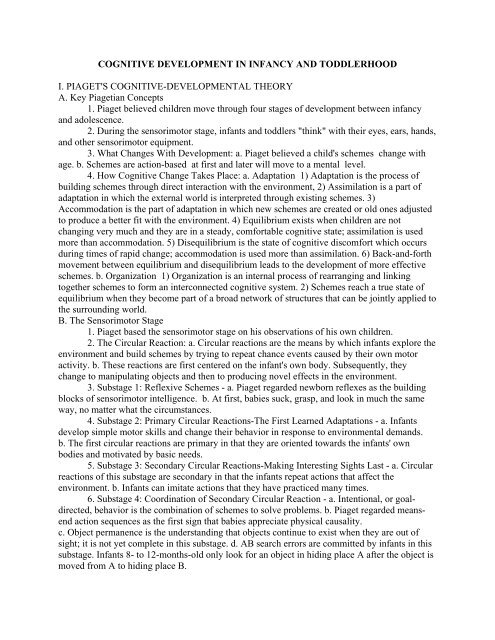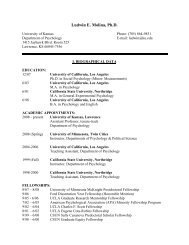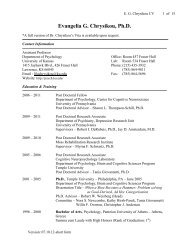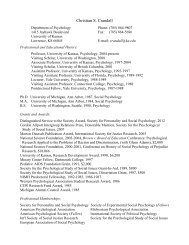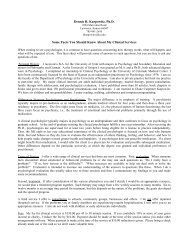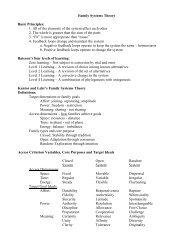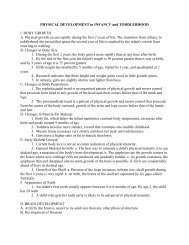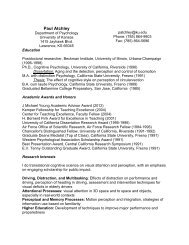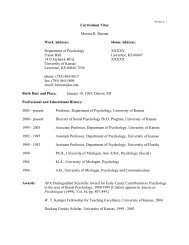COGNITIVE DEVELOPMENT IN INFANCY AND TODDLERHOOD I ...
COGNITIVE DEVELOPMENT IN INFANCY AND TODDLERHOOD I ...
COGNITIVE DEVELOPMENT IN INFANCY AND TODDLERHOOD I ...
You also want an ePaper? Increase the reach of your titles
YUMPU automatically turns print PDFs into web optimized ePapers that Google loves.
on infant cognition. d. Piaget's observations have been of great practical value, particularly forteachers and caregivers.II. <strong>IN</strong>FORMATION PROCESS<strong>IN</strong>GA. Information processing focuses on many different aspects of thinking such as attention,memory, categorization skills, and problem solving.B. The Structure of the Information-Processing System1. Mental strategies operate on and transform information, increasing the efficiency ofthinking as well as the chances that information will be retained.2. Information first enters the sensory register where sights and sounds are briefly heldbefore they decay or are transferred to short-term memory.3. Working, or short-term, memory is the conscious part of the mental system whereinformation is actively "worked" on to ensure that it will be retained.4. Long-term memory is the limitless permanent knowledge base.5. Categorization of information increases the likelihood that information will be easilyretrieved from long-term memory.6. The capacity of the mental system, the amount of information that can be retained andprocessed at once, expands with age.C. Attention1. Infants gradually become more efficient at managing their attention, takinginformation in more quickly.2. Research reveals that preterm and newborn infants require a long time to habituate anddishabituate to novel stimuli.3. By 4 months, infants attention becomes more flexible and they are better able todisengage or shift attention from one stimulus to another.4. Sustained attention improves throughout the first year.5. With age, infants and toddlers become more interested in what others are attending to.D. Memory1. Habituation research indicates 3-month-old infants can recognize a stimulus 24 hourslater.2. Recognition is a type of memory that involves noticing whether a stimulus is identicalor similar to one previously experienced.3. Recall is a type of memory that involves remembering a stimulus that is not present; bythe middle of the first year, infants can engage in recall.4. Infantile amnesia, or the fact that practically none of us can remember events beforeage 2 or 3, may be due to brain development during early childhood. Alternatively, it may be dueto the emergence of autobiographical memory, which occurs during the preschool years.E. Categorization1 . Evidence indicates that infants organize their physical, emotional, and social worlds.2. By the end of the first year, categories are conceptual-based on function and behavior.3. During the second year, children actively categorize items during their play.F. Evaluation of Information-Processing Findings1. Information-processing research emphasizes the continuity of thinking from infancyinto adulthood.2. One drawback to this approach is that, although it separates the different componentsof cognition , it does not build a broad, comprehensive theory of cognitive development.
3. More recent theorists have combined Piaget's theory with the information-processingapproach or applied a dynamic systems view to early cognition to overcome this weakness.III. THE SOCIAL CONTEXT OF EARLY <strong>COGNITIVE</strong> <strong>DEVELOPMENT</strong>A. Vygotsky believed that complex mental functions originate in social interaction.B. The zone of proximal development refers to a range of tasks that a child cannot yet handlealone, but can do with the help of more skilled partners.C. Research indicates that adult guidance and support within the zone of proximal developmentis related to advanced play, language, and problem-solving skills during the second year.IV. <strong>IN</strong>DIVIDUAL DIFFERENCES <strong>IN</strong> EARLY MENTAL <strong>DEVELOPMENT</strong>A. Cognitive theories are concerned with the process of development. In contrast, mental testsmeasure cognitive products that reflect mental development.B. Infant Intelligence Tests1. Most infant tests consist of perceptual and motor responses as well as some tasks thatmeasure early language and problem solving.2. The Bayley Scales of Infant Development consist of the Mental Scale, which includesitems such as turning to a sound and looking for a fallen object; and the Motor Scale, whichassesses gross and fine motor skills.3. Infant test scores may not accurately reflect abilities because the babies are likely tobecome distracted, tired, or hungry during test administration.4. Computing Intelligence Test Scores: a. Results for people at each age level form anormal or bell-shaped curve, in which most scores fall near the center and progressively fewerfall out toward the extremes. b. An intelligence quotient is a score that permits an child'sperformance on an intelligence test to be compared to the performances of other children of thesame age.5. Predicting Later Performance from Infant Tests: a. Although infant tests are carefullyconstructed, they are poor predictors of later intelligence. b. In one study, the average IQ shiftbetween 2 and 17 years of age was as great as 28.5. points. c. Infant test scores are calleddevelopmental quotients rather than lQs because they do not tap the same intelligencedimensions measured at older ages. d. Infant test scores have somewhat better long-termprediction for extremely low-scoring babies. e. The habituation-dishabituation response andPiagetian object permanence tasks predict IQ more effectively than traditional infant measures.C. Early Environment and Mental Development1. The Home Environment: a. The Home Observation for Measurement of theEnvironment is a checklist for gathering information about the quality of children's home livesthrough observation and parental interviews. b. An organized, stimulating physical setting andparental encouragement, involvement, and affection repeatedly predict infant and earlychildhood IQ, regardless of SES and ethnic group. c. When parents are intrusive with questionsand instructions, infants and toddlers are likely to be distractible, show less mature forms of play,and do poorly on mental tests.2. Infant and Toddler Day Care: a. Today, over 60 percent of mothers with a child underage 2 are employed. b. Quality of day care has an impact on children's mental development andsocial skills. c. Developmentally appropriate practice is a set of standards that specify programcharacteristics that meet the developmental and individual needs of young children of varying
ages, based on current research and consensus of experts. d. Day care in the U.S. is affected by amacrosystem of individualistic values and weak government regulation and funding.D. Early Intervention for At-Risk Infants and Toddlers1. Studies indicate that children of poverty are likely to show gradual declines inintelligence testscores and to achieve poorly when they reach school age.2. Interventions for infants and toddlers are either center- or home-based. The CarolinaAbecedarian Project is a center-based project that demonstrates the benefits of continuous, highqualityenrichment from infancy through the preschool years.3. The more intense the intervention, the greater the intellectual gains of participatingchildren.V. LANGUAGE<strong>DEVELOPMENT</strong>A. On average, children say their first word at around 12 months of age, with a range of 8 to 18months.B. Between 1.5 and 2 years, toddlers combine two words; soon their utterances increase in lengthand complexity.C. Three Theories of Language Development1. The Behaviorist Perspective: a. This perspective regards language development asentirely due to environmental influences. b. Through operant conditioning, parents reinforce theirbaby's sounds that most sound like words. c. Imitation combines with reinforcement to promotelanguage development.2. The Nativist Perspective: a. This view assumes that children are born with abiologically-based system-called the language acquisition device -for mastering language. b.Chomsky maintained that the LAD contains a set of rules common to all languages; thus,children speak in a rule-oriented way from the beginning. c. Children all over the world tend tomaster language milestones in a similar sequence- evidence that fits with Chomsky's ideas. d.Can Great Apes Acquire Language? a) Findings reveal that the ability of chimps to acquire ahumanlike language system is limited. b) Even pygmy chimps, a highly intelligent species,require several extra years of training to attain the basic grammar understood by human 2- and 3-year-olds. e. Language Areas in the Brain a) Humans have evolved specialized regions in thebrain that support language skills. b) Broca's area, located in the frontal lobe, controls languageproduction. c) Wernicke's area, located in the temporal lobe, controls language comprehension. f.Limitations of the Nativist Perspective 1) Researchers have had difficulty identifying the singlesystem of grammar believed to underlie all languages. 2) Research indicates that languageacquisition is not immediate but occurs in a steady and gradual manner.3. The Interactionist Perspective: a. This view emphasizes that language achievementsemerge through the interaction of innate abilities and environmental influences. b. Nativecapacity, a strong desire to interact with others, and a rich linguistic and social environmentcontribute to budding a child's language capacities. c. A great deal of evidence supports theinteractionist position.D. Getting Ready to Talk1. Cooing and Babbling: a. Around 2 months, babies make vowel-like noises calledcooing. About 6 months, consonants combine with vowels and the baby begins babbling. b.Babies must hear human speech for babbling to develop further. c. Adult-infant interactionincreases the amount of spoken language a baby is exposed to.


